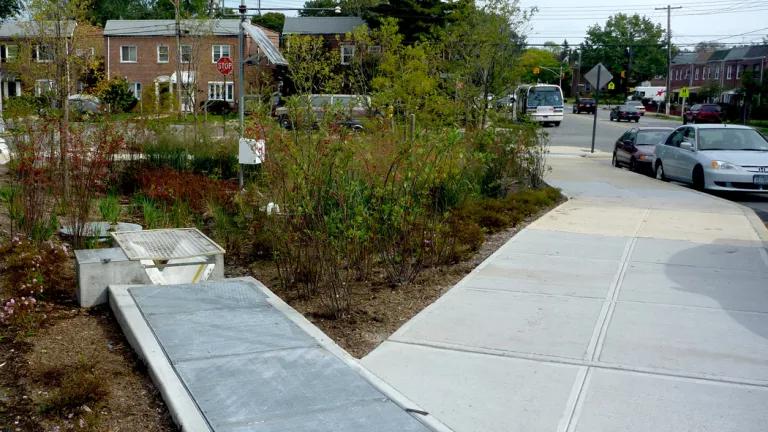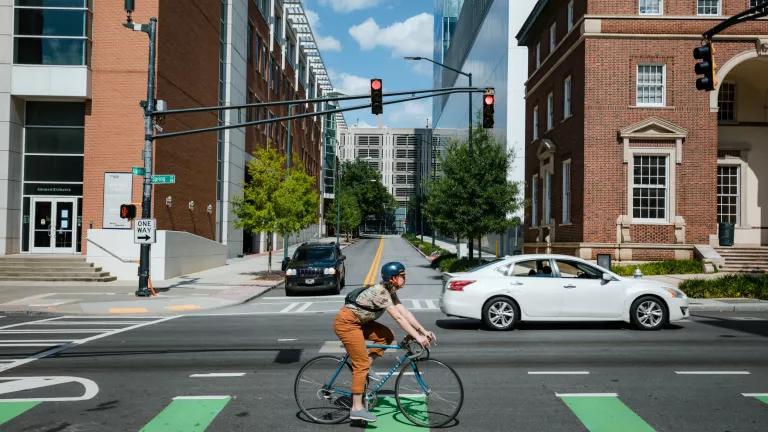
This is part of a series of NRDC blogs reflecting on the one-year anniversary of Superstorm Sandy. NRDC’s “Top Ten” post-Sandy priorities for government action can be found here.
Last year around this time, the night Superstorm Sandy hit, I barely made it out of New York’s JFK Airport for a work trip to California -- on one of the last planes to leave before the airport shut down. It was a strange feeling, heading away from my home as the storm barreled in, and even stranger watching the scenes of devastation on TV the next day, from three time zones away. I was fortunate that my own neighborhood was not in a flood zone. But millions of others, of course, weren’t so lucky. Their flight from their homes wasn’t on an airplane for a four-day work trip, but was rather the start of a long, strange trip filled with loss.
As we approach the first anniversary of Sandy, it’s important to focus not only on the loss, but on what we can do to prevent a repeat performance. Storm damage is caused by wind, waves, and rain, of course, but also by the vulnerabilities in how we have designed our buildings, our infrastructure, and our communities. As we continue to rebuild and prepare for future storms, we can, and must, do better.
We can’t prepare only for the next Sandy.
Flood damage from hurricanes and other major storms comes in two main varieties – coastal storm surges driven by high winds and tides, and inland flooding from huge downpours of rain. Sandy’s worst damage was of the storm surge variety, racking up $50 billion in damage as it slammed into the northeastern seaboard and destroyed lives, homes, and businesses,.
But, lest we forget, just a year earlier, Hurricane Irene dumped a deluge of rain that caused catastrophic inland flooding in several northeastern states, with damages of nearly $16 billion, and Tropical Storm Lee similarly inflicted over $1 billion of damage across a large swath of the eastern U.S.
It’s also important to remember that -- especially in developed areas where pavement and other hard surfaces keep rainwater from seeping into the ground -- it doesn’t take a hurricane or a tropical storm to cause flooding. The Federal Emergency Management Agency (FEMA) estimates that up to 25 percent of economic losses from flooding are the result of poor urban drainage, not from being located in a floodplain: “Shallow, localized flooding…all too often escapes the attention received by larger floods….Over the years the cumulative damage and recurring disruption from localized flooding can be more than that caused by flooding on major rivers and streams.”
The good news is that, even as we work to curb the global warming emissions that fuel nature’s fury, we can also work with nature to rebuild smarter and improve our communities’ resilience to both inland and coastal flooding. Here’s how:
- Increase investments in cost-effective “green infrastructure” to help absorb stormwater runoff, while beautifying communities.
A growing list of communities across the country are investing in green infrastructure – like roadside plantings, expanded tree pits, parks, green roofs, and porous pavements -- to keep pollution out of urban waterways. These same techniques, because they work by absorbing storm runoff, also help reduce the risks of inland flooding. The federal, New York State, and New York City post-Sandy resiliency plans all recognize this.
In both Superstorm Sandy and Hurricane Irene, this green street on Nashville Ave., in Queens, NY, effectively captured all of the runoff from a surrounding paved area more than 30 times its size. (Photo: NYC Parks)
Moreover, investments in urban green space improve our communities year-round – not just when a storm hits. Green infrastructure serves to beautify and revitalize neighborhoods, cool and cleanse the air, reduce asthma and heat-related illnesses, help save on heating and cooling energy costs, and boost local economies and support American jobs.
Last September, not long before Sandy, New York State awarded grants for demonstration projects in three communities, intended to showcase the use of green infrastructure for flood control. The state previously put federal economic stimulus funds to use supporting green infrastructure planning efforts in several upstate regions. Over the last four years, New York has also directed tens of millions of dollars towards construction of green infrastructure projects, with a focus on reducing pollution from urban runoff.
With tens of billions of dollars in federal Sandy recovery money flowing to New York state, now is the time to super-charge these efforts across the state. For example, the state could direct substantial new funding to flood-prone areas for the creation of “green streets,” lined with trees and plants that absorb runoff. (To maximize benefits, the state should prioritize projects that are designed to optimize both flood mitigation and reduce polluted runoff. There’s no shortage of opportunities, as urban runoff is a leading cause of water pollution statewide.)
New York City is already making green streets a prominent part of its long-term plan to capture runoff and reduce sewage overflows. Many of these installations have been sited in locations with recurrent flooding issues, and Mayor Bloomberg’s post-Sandy resiliency plan pledged a new initiative to examine the wider use of green streets specifically for flood control.

Green street on Seagirt Blvd., Far Rockaway, Queens, NY (Photo: NYC Parks)
State and federal transportation funding can also make a major contribution to green streets efforts. New York could follow the lead of Tuscon, Arizona, for example, which recently adopted a policy to design all new roadway projects as green streets. That means investments in streets will also become investments in green infrastructure.
- In coastal areas, advance implementation of “natural barriers” (such as wetland restoration, dunes, oyster reefs, and sea grass) to protect communities from storm surges and seal level rise.
As we learned all too well in Sandy, coastal development is extremely vulnerable to flooding from storm surge. Nature has a way of guarding against these risks: natural features such as tidal marshes, dunes, oyster reefs, and sea grass act as shock absorbers against pounding waves and absorb or block flood waters.
Famously, Long Beach, NY, which had refused to build dunes years ago, bore the brunt of Sandy, while neighboring towns in Long Island escaped with much less damage.
In New York City, Jamaica Bay’s disappearing marshes provide a critically important buffer for the southern shorelines of Brooklyn and Queens – if they can be preserved and restored.

Jamaica Bay marshes with NYC skyline in background (Photo: Larry Levine)
Again, the federal, New York State, and New York City post-Sandy resiliency plans all recognize the value of these natural infrastructure approaches. Now the funding needs to follow.
Money is starting to flow to such projects. New York State recently announced about $650,000 of funding for a Jamaica Bay marsh restoration project aimed at increasing resiliency to climate change. New York City, the federal government, and academic institutions are collaborating on a new urban climate resiliency institute focused on Jamaica Bay. And a settlement between NRDC and New York City is directing $15 million to marsh restoration in the bay from 2011-2014. But much more resources are needed.
Congress has tasked the Corps of Engineers with conducting a post-Sandy evaluation of coastal storm protections. Although the Corps has said it will examine natural barriers as part of its study, the Corps has a long history of favoring hard infrastructure that works against, rather than with, nature. We’ll be watching closely to see how the Corps recommends that Congress spend future taxpayer dollars.




